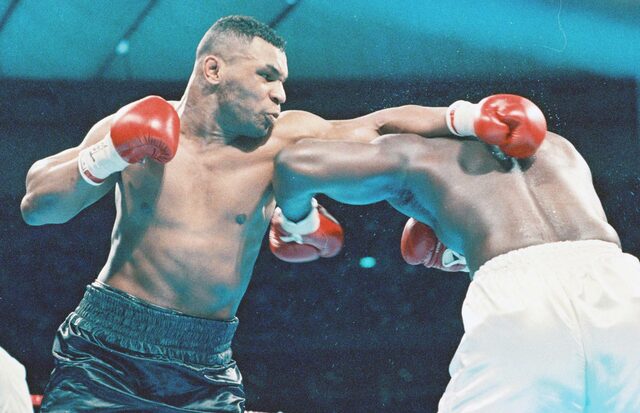
Heavyweight boxing attracts the attention of boxing fans around the world due to its epic matches and legendary champions.
This category is the ultimate test of strength and skill displayed by boxers, and its thrills and drama are unique to any other weight class.
This complete guide delves into the appeal of heavyweight boxing, highlighting all aspects of the weight class, including history, technique, and strategy.
Heavyweight boxers need to be not only strong, but also strategically and technically excellent.
Throughout this article, we’ll take a deep dive into heavyweight boxing’s rich history, basic training methods, strategies, and what the future holds.
Whether you’re just getting interested in heavyweight boxing or you’re a long-time fan, the insights provided in this guide will help you enjoy the sport even more.
目次
Introduction to heavyweight boxing
Heavyweight boxing is the category with the highest weight limit and requires the most physical strength and endurance.
There is no weight limit for this division, and athletes typically compete at 90.72 kilograms (200 pounds) or above.
The heavyweight division is also known as the “King of the Ring,” and its matches receive particular attention, often making it the face of the sport.
What is heavyweight?
Heavyweight is the heaviest category in boxing and is considered an unlimited weight class.
Boxers in this weight class typically have more pronounced body size, punching power, and physical strength than fighters in other weight classes.
Historically, heavyweight matches have attracted a lot of attention and produced many legendary champions.
Great athletes like Muhammad Ali and Mike Tyson made their names in this weight class and made their names known around the world.
Heavyweight characteristics and charm
The biggest appeal of the heavyweight division is its overwhelming power and dramatic KO victories.
Matches are often unpredictable and a single blow can often decide the outcome. In addition, heavyweight boxers are not just a mass of strength; they fight using advanced techniques and strategies.
Boxers with a combination of speed and skill are often successful, which is one of the reasons they attract so many spectators.
This weight class is also where all aspects of boxing technique are tested to the fullest.
Heavyweight boxers are constantly pushing themselves to the limit because it requires endurance, technique, and strategic thinking.
For this reason, heavyweight bouts have special meaning for boxing fans, and each time a bout in this weight class takes place, it attracts worldwide attention.

Heavyweight history and influence
The history of heavyweight boxing is one of the most dramatic and influential in the sport.
The heavyweight division has been at the heart of boxing ever since it was established as an official weight class in the late 19th century.
This division has produced some of the most iconic athletes not only in boxing, but in all sports.
greatest heavyweight champion of all time
Many great champions made their name in the heavyweight division, including John L. Sullivan, Jack Johnson, Joe Louis, Muhammad Ali, George Foreman, Mike Tyson, Evander Holyfield, and Lennox Lewis. Ta.
In their respective eras, these athletes became more than just sportsmen, they became global celebrities and cultural influences.
Muhammad Ali, in particular, was nicknamed “The Greatest” for his charisma and influence on society, and is still remembered by many today.
The impact of the heavyweight division on boxing
The heavyweight division has always been the most visible weight class in the sport of boxing, and plays a central role in the media and public events.
Heavyweight bouts have become big business, generating large amounts of prize money and advertising revenue.
Matches in this weight class are often seen as emblematic of the image of boxing and have greatly contributed to the popularization of the sport.
The heavyweight division was also the scene of technological advances, leading to many innovations in training methods and tactics.
The legacy of these great fighters and their era has had a profound influence on modern heavyweight boxers, who are called upon to follow the high standards set by past champions. .
The history of the heavyweight division and the stories of its fighters continue to be fascinating not only to boxing fans, but also to fans of the sport in general.

Heavyweight training and preparation
Thorough and specialized training is essential for heavyweight boxers to compete at the top level.
Athletes in this weight class are particularly demanding of physical strength and power, so their training methods and pre-fight preparation must be more rigorous and comprehensive than in any other weight class.
A heavyweight boxer’s training program focuses on developing agility and technique while making the most of their size and strength.
How to train a heavyweight boxer
Heavyweight boxer training typically combines advanced strength and endurance training.
Strength training includes weightlifting with free weights and bodyweight exercises.
This increases the power of your punches and at the same time builds the endurance needed during the match.
Agility drills and speed training will also be actively incorporated to improve speed and reaction time.
Additionally, shadow boxing, heavy bag, speed bag, and pad work are performed on a daily basis to develop boxing-specific skills.
Pre-game preparation and mindset
Pre-game preparation starts with keeping your physical condition in peak condition. Nutritionally, it is important to manage your diet to maintain weight while optimizing your energy levels.
Mental preparation typically includes relaxation techniques and psychological coaching.
This allows athletes to manage mental pressure and improve concentration.
Also, formulating a specific strategy is an important pre-game process. Analyzing your opponent’s fighting style and systematically formulating a strategy to exploit their weaknesses will lead directly to victory.
This combination of training and preparation ensures that heavyweight boxers are physically and mentally ready for the fight.
As a result, in-ring performance is maximized, giving the audience an unforgettable match.

heavyweight strategy and tactics
In heavyweight boxing, strategy and tactics are important factors that determine the outcome of a fight.
Boxers in this weight class must hone their offensive techniques and defensive strategies to take advantage of their large physiques and powerful punches.
Psychological warfare during the match is also very important, and approaches and mental maneuvers that take the opponent by surprise are the keys to victory.
These techniques and tactics must be finely tuned to each player’s style and opponent characteristics.
Offensive techniques and defensive strategies
A heavyweight boxer’s attacking techniques include powerful straight punches, hooks, and uppercuts.
These punches have the ability to cause significant damage to the opponent and often result in a KO.
Additionally, these attacks require precise timing and positioning to be effective.
A common defensive strategy is to keep the guard high and aim for a counter attack.
Effective blocking and evasive movements allow you to negate your opponent’s attacks and maintain your own rhythm.
Psychological warfare and approaches during matches
Psychological warfare is very important in heavyweight matches. Athletes need to be confident in the ring and this can put pressure on their opponents.
Pre-match taunts and in-ring demeanor can disrupt an opponent’s concentration. It is also effective to use strategic feints to deceive your opponent and gain advantageous positions.
Judgment and calmness during a match are important factors in dealing with unexpected situations and leading to victory.
These combinations of offensive techniques, defensive strategies, and psychological warfare allow heavyweight boxers to control matches and ultimately emerge victorious.
A great performance in the ring is the result of a high level of strategic preparation and technical skill, which creates an engaging spectacle for the audience.

nutrition and weight management
Proper nutrition and weight management are extremely important for heavyweight boxers.
There is no weight limit in this weight class, so athletes must find a balance between maximizing their power and maintaining optimal physical condition.
Proper meal planning and weight management strategies are essential not only to improve match performance, but also to maintain energy levels during training and minimize the risk of injury.
heavyweight boxer meal plan
A heavyweight boxer’s diet plan must be high in calories and nutritionally balanced.
Protein is essential for muscle repair and growth and should be consumed in sufficient amounts. In general, lean meats, poultry, fish, legumes, and dairy products are recommended as good sources of protein.
Carbohydrates are important sources of energy, and complex carbohydrates from whole grains, fruits, and vegetables provide sustained energy.
Healthy fats also support overall health, with fish, nuts and olive oil rich in omega-3 fatty acids recommended.
Maintaining weight management and performance
For heavyweight boxers, weight management doesn’t just mean gaining weight, it also means maintaining a lean, muscular body by keeping body fat percentages at an appropriate level.
This involves regular weight measurements and body composition analysis, and the diet plan is adjusted as necessary.
Hydration is also important; proper water balance helps your body function optimally and improves performance.
These nutritional and weight management approaches allow heavyweight boxers to perform at their best in training and competition.
Proper diet and weight management allows athletes to stay in shape and compete in important matches in optimal condition.

Heavyweight future and prospects
Heavyweight boxing is a constantly evolving sport, with its future being shaped by new techniques, training methods, and rising talent.
Understanding how the division continues to evolve is of great interest to fans, trainers, and fighters alike, and is an important factor in thinking about the future prospects of the heavyweight division.
Rising stars and future champions
Discovering new talent is essential to the future of heavyweight boxing.
The next generation of stars from all over the world are emerging and showing their talent in the ring.
These young fighters have adopted innovative training techniques and tactics to further elevate the level of heavyweight competition.
Due to their technical proficiency and physical conditioning, they are expected to emerge as heavyweight champions in the coming years.
Heavyweight trends and evolution
Advances in sports science have greatly contributed to the evolution of heavyweight boxing.
Optimized training methods, advances in nutrition, and improvements in injury prevention and treatment techniques are directly linked to improved performance in athletes.
Boxing technology itself has also evolved, incorporating more precise and calculated tactics.
This makes matches more strategic and technically advanced, adding to the spectacle.
The future of heavyweight boxing looks bright with technological innovation and a new generation of fighters.
It will be interesting to see how these fighters transcend themselves and take the tradition of heavyweight boxing to the next level.
This heavy weight class will continue to attract many fans.

Heavyweight boxing culture and media
Heavyweight boxing has deep roots not only in the world of sports, but also in the wider cultural media landscape.
More than just sporting events, matches in this weight class often become iconic events in popular culture.
The media conveys the excitement and drama of heavyweight boxing to the world, often sparking sociocultural debate.
Heavyweight boxing and media relations
Heavyweight boxing has had a close relationship with the media since the beginning of television broadcasting.
Important matches often attract international attention and draw large audiences.
In modern times, the rise of the internet and social media has made it possible for fans not only to follow matches in real time, but also to interact directly with players.
This media evolution is providing new opportunities for marketing and brand building for heavyweight boxers, with the fighters themselves increasingly making effective use of media platforms.
Boxing and sociocultural influences
Heavyweight boxing has influenced many social and cultural issues.
For example, athletes like Muhammad Ali, through his accomplishments and charisma, have raised awareness of various social issues such as racism and religious issues.
Boxing also has a significant economic impact, contributing to increased tourism income and job creation, especially in areas where large-scale matches are held.
In this way, heavyweight boxing is not only interesting as a sport, but also plays an important role in society.
Understanding how heavyweight boxing is connected to culture and media reveals why this sport is so much more than just a competition.
It has the power to connect people around the world and sometimes stimulate important social discussions.

in conclusion
Heavyweight boxing continues to captivate sports fans around the world with its overwhelming power and technique.
Success in this weight class requires excellent technique, strong physical strength, and unwavering mental fortitude.
Only boxers who possess these elements can rise to the top of the heavyweight division.
Here are the keys to success as a heavyweight boxer and some encouragement for athletes who want to pursue this career.
The key to success in heavyweight boxing
To be successful, it is important to first stay true to the basics.
It requires mastery of technology, understanding of strategy, and the ability to combine them.
Proper training and nutritional management to maintain your best physical condition are also essential for success.
Additionally, heavyweight boxers must develop the ability to control psychological warfare in a match and remain calm under pressure.
A high level and well-balanced combination of these elements guarantees success in the heavyweight ring.
Encouragement for athletes challenging for the heavyweight division
For all athletes who challenge for the heavyweight division, the journey is never easy, but the challenge leads to personal growth.
The experience gained by overcoming obstacles will give you confidence both inside and outside the ring, and will motivate you to aim for even greater heights.
It is important to have the courage to continue trying without fear of defeat, and to always seek self-improvement.
Walking the path as a heavyweight boxer is an opportunity to grow not just as an athlete, but as a mature person.
The world of heavyweight boxing is a tough one, but the joy of achieving success in it is immeasurable.
In this competition that tests your technique, physical strength, and mental strength, please spare no effort to achieve glory and move forward toward your dreams.



